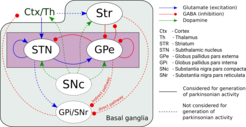Computational Modeling of Basal Ganglia and Parkinson's Disease
Explanation of features of Parkinsonian neural dynamics via mechanistic descriptions of phase transitions in computational models of basal ganglia interactions.
The basal ganglia are a set of subcortical nuclei that form different feedback loops with thalamo-cortical circuits in the sensorimotor, associative and limbic domain [1,2]. Parkinson's Disease (PD) is a movement disorder that has been related to basal ganglia dysfunction [3]. In the healthy state, neural activity in the basal ganglia shows little synchrony, neither within nor across nuclei. In Parkinsonian states, on the other hand, increased neural synchronization and bursting behavior has been reported in all major structures of the basal ganglia and the involved cortices [4]. Most prominently, exaggerated neural synchronization in the lower (13-15 Hz) or upper (20-30 Hz) beta frequency band have been found in motor cortices and different basal ganglia structures such as subthalamic nucleus (STN), globus pallidus pars externa/interna (GPe/GPi), or striatum (STR). Neural synchronization in this frequency range has been shown to correlate with motor symptoms such as bradykinesia and is reduced by clinical intervention methods known to counteract motor symptoms in PD. We aim to explain features of Parkinsonian neural dynamics via mechanistic descriptions of phase transitions in computational models of basal ganglia circuits (see Fig. 1).

Figure 1: Internal structure of the basal ganglia. Solid lines mark populations and connections that are investigated in detail in the projects outlined below.
[1] Bolam JP, Hanley JJ, Booth PAC, Bevan MD. Synaptic organisation of the basal ganglia. Journal of Anatomy. 2000; 196(4): 527–542.
[2] Nakano K. Neural circuits and topographic organization of the basal ganglia and related regions. Brain & Development. 2000; 22(Suppl 1): 5-16.
[3] Bergman H, Deuschl G. Pathophysiology of Parkinson's disease: From clinical neurology to basic neuroscience and back. Movement Disorders. 2002; 17(3): 28-40.
[4] Wilson CJ. Active Decorrelation in the Basal Ganglia. Neuroscience. 2013; 250: 467-482.
